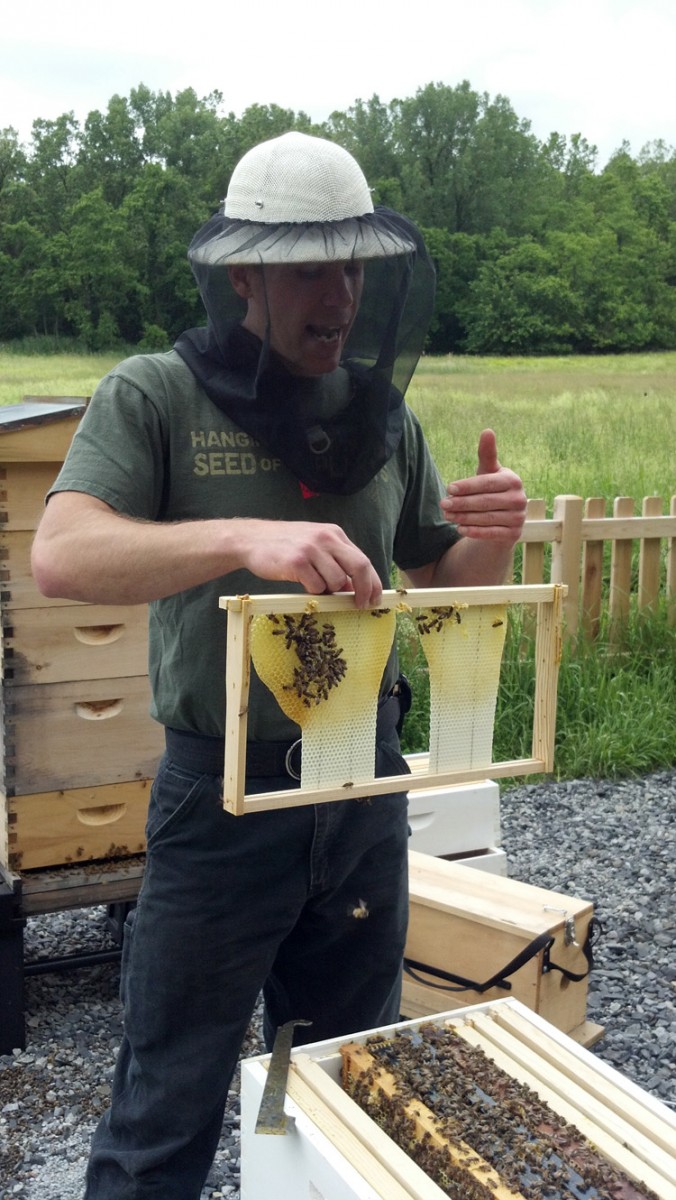MOUNTAINVILLE, N.Y.—Colin Coyne gently nudged honeybees aside with a metal tool. Bare-armed and wearing a beekeeper’s hat with no other protective gear, he lifted a frame covered with the insects from his youngest hive.
“I don’t use smoke. Smoke tells them there is a fire and they are going to have to move, so they need to eat a lot of honey to have strength for the trip. It doesn’t calm them, it distracts them,” said Coyne. He chooses not to subject his bees to any unnecessary stress. “I respect them.”
A cross between an Eagle Scout and a Jedi Knight, Coyne keeps his bees in the sculpture garden at Storm King Art Center in New York’s Hudson Valley. The apiary, a place where colonies of bees are kept, is part of the temporary “Light and Landscape” exhibit. According to a statement from artist Peter Coffin on the Light and Landscape website, the project “involves working with familiar things—here, the sun, bees, honey—to see them anew. That these small colonies also rely on the sun is a reminder of the sun’s omnipotence.”
For Coyne, the colonies are about more than art.
Colony Collapse Disorder (CCD) refers to the unexplained losses of bee colonies, and according to the U.S. Department of Agriculture (USDA) CCD Progress Report, the disorder has been increasing. In 2009, 29 percent of bee colonies succumbed to CCD, and in the following year, 34 percent died from the mysterious syndrome.
The report states: “Colonies with poor health, including colonies with CCD symptoms, exhibited increased pathogen levels and evidence of pesticide residues … Losses are a major problem for the beekeeping industry and potentially to commodities that depend on bees for pollination services.”
CCD has multiple causes, and pesticides are clearly one culprit, according to the USDA. Coyne said that neurotoxic pesticides directly kill bees, lower their immunity, and disrupt their navigational ability so that they get lost and die without being able to return to their hives.
Yet bees are essential to national and global food supplies. If pollinators were to die out, famine would follow.
Coyne says home beekeeping is a way to help bees survive.
He demonstrates the process at the art center, hoping to educate potential apiarists.
Of the four hives at the center, two are infested with varroa mites, a parasite that transmits disease to the bees. However, Coyne has found that one strain of bee is adapting.
“The Russian bees have guards at the door of the colony. If a worker comes in with a mite on her back, the guards stop her and pull it off,” explained Coyne. He has treated the infected hives with oxalic acid, which dries up the mites, but he thinks the long-term answer is for the insects to find a way to thrive with tolerable levels of mites.
Coyne slowly replaced his bee-covered frame and drew out a new one with a little honeycomb on it. It had comb-patterned wax starter panels, meant to guide the bees to build combs. Commercial honey operations use plastic starter panels with a small comb pattern that only allows worker bees to hatch, according to Coyne. A larger size comb is needed for male bees, known as drones. “Because the drones don’t make any honey, they don’t care about them. The colony can’t sustain itself [without drones] but they just buy new bees rather than letting them breed naturally.
“They are not thinking about the bees’ needs.”
Coyne said that a network of city and rural home beekeepers could counteract the unsustainable practices of commercial honey growers and support a diverse supply of healthy colonies.
Coyne believes that humans have an obligation to use nature in a friendly and respectful way.
“I can be 50 miles away and bees will come up and say hello to me,” he said. “I don’t know how they know.”
The Epoch Times publishes in 35 countries and in 19 languages. Subscribe to our e-newsletter.







